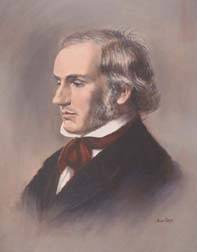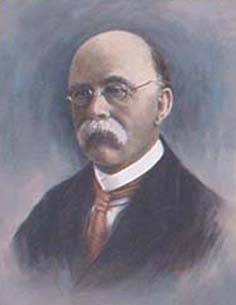A series of twelve portraits by Anna O’Leary hang in the Visitor Centre.
These portraits show notable scientists and innovators associated with the development of botany, as well as the establishment and growth of the National Botanic Gardens of Ireland, Glasnevin and Kilmacurragh.
Scroll down to learn more about each portrait, and discover the unfolding history of the Gardens as you read about each man.
You can also navigate this page by using the menu to the left to jump to a specific portrait.

Carl Linnaeus (1707 – 1777, Sweden)
Carl Linnaeus devised the basis of scientific nomenclature, whereby every organism has a Binomial Name. These ‘scientific’ or ‘Latin names’ are vital to provide an international language for naming organisms – for example Digitalis purpurea is known as Lus mór (Irish) Foxglove (English) Fingerhut (German) Pour Prée (French). In the eighteenth century many European floras were still using different names for the same species, and Linnaeus’ book Species Plantarum, published in 1753, unified all these names for the first time. Linnaeus’ principles for naming plants are still used today, and when a plant species is first described this must be done in the Latin language.

Charles Darwin (1809 – 1882, England)
The idea of evolution was not coined by Charles Darwin; indeed, in his day the very term meant to unroll (e-volve) or to ‘reveal’ the divine plan. His contribution was in marshalling powerful evidence supporting the fact of evolution, and in devising a hypothesis explaining the mechanism of evolution (the fact that all plant and animal species had arisen by this process of gradual change). The publication of his book On the Origin of Species by Means of Natural Selection, or the Preservation of Favoured Races in the Struggle for Life in 1859 laid the foundations for modern evolutionary biology.

Gregor Johann Mendel (1822 – 1884, Austria)
Gregor Mendel was a member of the Augustinian monastery in Brünn, Austria (now Brno, Czechoslovakia). He carried out breeding experiments on garden peas, starting in about 1856. He carefully isolated plants and transferred pollen from one to another, collected and sowed the seed, and recorded the characteristics of all the offspring. Through these experiments he was able to demonstrate how ‘factors’ were inherited from one generation to the next, and his conclusions form the foundations of the study of heredity and modern genetics.

Robert Loyd Praeger (1865 – 1953, Ireland)
Born in Hollywood, County Down, Praeger was considered one of the greatest of Irish field botanists. There is little known of his early family life. He was a member of the Belfast Naturalist Field Club from an early age, and developed a keen interest in Natural History. In 1886 he graduated from Queen’s College in Belfast with a degree in Engineering and worked for a time on the construction of the Alexander Docks in Belfast. In 1893 Praeger moved to Dublin and joined the staff of the National Library.
From the 1880s to the 1950s, Praeger played a major role in the development of Irish natural history. The Clare Island Survey (1909-1922) and the Lambay Survey (1905-1906) were two projects he was involved with. He was also a prolific writer. Two of his books, The Way That I Went (1937), and Irish Topographical Botany (1901) are still highly regarded today.

David Moore (1808, Dundee – 1879, Dublin)
David Moore was born in Dundee, Scotland. After serving his gardening apprenticeship in Scotland, he moved to Ireland in 1828. He worked as assistant to James Mackay at Trinity College Botanic Gardens at Ballsbridge. Following that he was appointed as botanist to the Ordnance Survey spending five years listing and collecting the native plants of Antrim and Londonderry. In 1838 he became curator of the National Botanic Gardens, succeeding Ninain Nivan. He remained there until his death in 1879. During his tenure at Glasnevin, orchids were grown from seed for the first time.
David Moore was internationally respected as a botanist and received an honourary doctorate from the University of Zurich for his work in Crytogamic (Spore plants) botany. In the 1860s he collaborated with A.G. More of the Dublin Museum to publish, in 1866, Cybele Hibernica, long the standard work on the distribution of the plants native to Ireland.

William Henry Harvey (1811, Limerick – 1866, England)
Harvey was a botanist, colonial administrator, and artist. He was appointed Colonial Treasurer of the Cape of Good Hope colony from 1836 to 1843. On his return to Ireland he became curator of the Trinity College Herbarium (1844–1866), and later Professor of Botany. At the same time he became Professor of Botany to the Royal Dublin Society (1848–1866). He collected plants (including many seaweeds) in Ireland, South Africa, Ceylon, Australia, and North America. He wrote the first flora of the Cape region of South Africa, as well the first seaweed flora to Britain and Ireland.

Augustine Henry (1857, Dundee – 1930, Dublin)
Augustine Henry was a plant collector, physician, and forester. Henry obtained his medical degree in Edinburgh. In 1881, aged 24, he travelled to China to take a post as assistant medical officer with the Imperial Chinese Customs Service. He collected plants in central and southern China, Taiwan, and Hainan. This was done in his spare time after his official duties, but nonetheless he collected some 16,000 dried specimens, of which more than 1,000 species proved new to science. He was appointed as the first Professor of Forestry to the Royal College of Science (later University College), Dublin (1913-1926). As well as publications on the economic botany of China, Henry also wrote an authoritative account of the Trees of Great Britain and Ireland (1906–1913) with H. J. Elwes.

William Robinson (1838, Ireland – 1935, England)
Robinson was a horticulturist, author, plantsman, and polemicist. William Robinson was not, as he occasionally claimed, a student gardener at the Royal Botanic Gardens, Glasnevin, nor is there explicit evidence for his exact origins. He was apprenticed at Curraghmore House (County Waterford), and later employed at Ballykilcavan (County Laois). He went on to found several journals, in particular The Garden and Garden Illustrated.
His influence on gardening at the time was profound. In 1870 he published a book entitled The Wild Garden, whose ideas are still a strong influence on gardening today. He favoured the naturalistic style of planting over the formal parterres, carpet bedding, and shrubberies of the Victorian era. The most comprehensive expression of his ideas came with the publication of The English Flower Garden in 1883, without doubt the single most important gardening book of the next century.

Sir Frederick Moore (1857 – 1949, Dublin)
Frederick Moore, the eldest son of David Moore, was born at Glasnevin in 1857. His early years were spent studying and training at the famous nursery at Vanoutte in Belgium, and the botanic gardens of the University of Leiden.
When David Moore died, Frederick, who was then Curator at Trinity College Botanic Gardens, was appointed his successor. Frederick became well known for his interest in orchids, and was responsible for setting up a world renowned collection of orchids at Glasnevin.
Under Frederick Moore’s curatorship the Botanic Gardens flourished, with many new plants introduced from abroad. He was knighted in 1911 for his services to horticulture. In 1922, at the age of 65, Frederick retired from Glasnevin.

Walter Wade (1750 – 1825, Dublin)
Walter Wade practised as a surgeon and midwife in Dublin around 1776. In 1789 he began giving public lectures on midwifery and botany in Dublin. He campaigned for a public botanical garden, petitioning the Irish parliament in 1790. He was elected Professor of Botany to the Dublin Society in 1796, and became the first Director of the Dublin Society’s Botanic Gardens, Glasnevin, until his death. He gave ‘practical lectures’ on botany and agriculture in the Director’s house at the Botanic gardens, a syllabus was published, and at one time it became highly fashionable for Dublin Society to attend these early morning lectures.

Richard Turner (1798 – 1881, Dublin)
Richard Turner was born in 1798 into a family with long associations with the iron trade. He was an innovative designer, and the high quality and decorative details of his glasshouses were famous throughout Europe. His ironworks, the Hammersmith Works, were at Ballsbridge in Dublin. Besides the Curvilinear Range here at the National Botanic Gardens, his works include the Palm House at Belfast Botanic Gardens, and the Great Palm House, Royal Botanic Gardens, Kew. His design for the Crystal Palace at the Great London Exhibition of 1851 was only rejected in favour of that of Paxton on the grounds of cost and speed of erection. His intuitive grasp of engineering design, and his pioneering skill at producing curved glazing bars of wrought iron to a standard plan, gave his buildings a lightness and elegance of design unmatched at the time.

John Foster (1740 – 1828)
John Foster was a lawyer, politician, and the last Speaker of the Irish House of Commons (1800). He was an avid collector of trees, and with a self-proclaimed ‘rage of planting’, he established a major arboretum at Oriel Temple (Collon, County Louth) as well as promoting agricultural improvement in Ireland. As speaker of the House of Commons, Foster had enormous political sway, and was certainly the force behind the success of Wade’s petition, so that on the 5th April 1790 the Dublin Society Bill provided £300 ‘towards providing and maintaining a botanic garden.’ He retained a keen interest in the gardens, and exerted a considerable degree of patronage as the ‘Fostering Mantle’. He believed that the gardens should be for the benefit of the practical farmer as well as the academic botanist.

